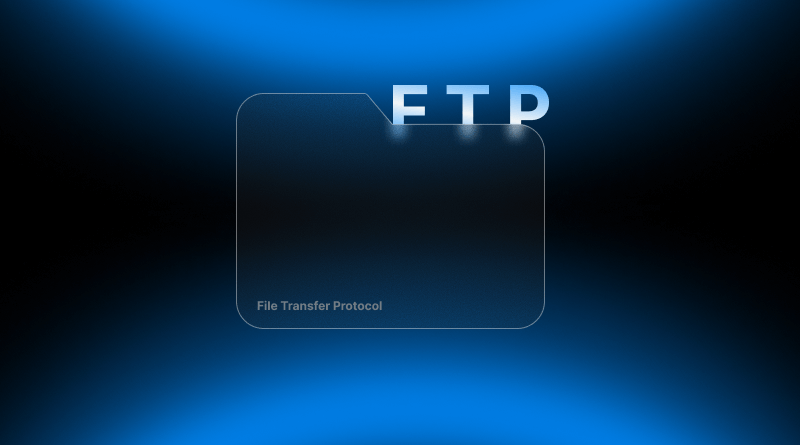Have you ever thought about how all of your website’s content goes online effortlessly?
Imagine creating an attractive webpage or developing a sophisticated web application. And with a few clicks, it is available for everyone on the internet. You might be wondering how those files travel from your machine to the web server. The solution is a simple but effective tool known as FTP (File Transfer Protocol).
FTP is similar to how a delivery company works. You secure the files of your website, ready to be delivered and designate your web server as the delivery point, and FTP will guarantee secure and accurate delivery of every file. Whether it is a developer uploading code, a blogger updating images, or a business modifying website content, FTP takes care of everything in the background.
For people responsible for online files, it is essential to learn about what FTP is and how to use it. It creates a dependable and direct link between your computer and your hosting server.
In this insightful blog, you will understand the fundamentals of the FTP file transfer protocol, its methods of operation, popular FTP tools, and its significance in website management despite today’s cloud technologies.
Table Of Content
What Exactly is FTP? Know the Definition
FTP or File Transfer Protocol, is a standard internet utility that enables the transfer of files from a personal computer to a server and vice versa. In easy terms, it is the simplest and most effective means of transferring data between a client and a server.
Like all other protocols, FTP also has its limitations. It cannot be used to transfer files between two remote computers. However, it does provide options for uploading, downloading, and deleting files as long as both machines are connected to the internet.
So, what is FTP in computer terms? Just like any other computer in the world, your personal computer uses multiple files that provide information about numerous tasks. A server is a central computer that provides data and services to other computers in the network. Users can access these files as long as they have the right permissions.
At its core, FTP operates on the client-server model. FTP is primarily used to link two computers that are located in different parts of the world. The transfer of data from one computer to the other in different locations is made possible through the use of a cable.
In a way, the FTP file transfer protocol serves as an intermediary mechanism between a user’s local device and their online accounts, allowing one to manage, update, or even perform backups on their websites and data. This is helpful to web developers, designers, and website owners. Knowing what FTP is allows them to manage the digital assets efficiently.
The Two Main Players: FTP Client and FTP Server
The FTP server and FTP client are the two main components that complete the overall FTP functioning. Together, they form the core of every successful file transfer with the use of the FTP protocol.
1. What is an FTP Server?
An FTP server is a computer system or software application that provides the service of storing files. It also controls access to them over a network using the FTP file transfer protocol. In other words, if FTP functions as a digital delivery system, then the FTP server acts as the storage warehouse where all data is stored and awaiting dispatch or reception.
So, what is an FTP server really doing behind the scenes? FTP servers wait and listen for connection requests from users. Upon successful connection, they can either upload files, download files, or manage FTP directories—all depending on the permissions granted by the server.
What about the location of the FTP servers? They can most often be found as part of a reliable web hosting provider’s infrastructure. When you buy hosting for your small business website, the hosting company will provide you access to an FTP server so you can manage website files remotely.
2. What is an FTP Client?
An FTP client is a software application that you can install on your computer and use to access FTP servers. FTP clients act as control panels for file transfers.
So, how does an FTP client work? It establishes a connection to the server, issues a set of commands (upload, download, rename, delete, etc.), and shows the user’s local files alongside server files in a graphical interface.
FileZilla, WinSCP, and Cyberduck are popular FTP client software. Using one is simple:
- Provide the server’s host name (most of the time your domain or an IP).
- Provide your FTP username and password.
- Manage files on your computer and the server after connecting.
The exchange between the FTP client and server illustrates the FTP process, which is an organized and secure way of transferring files and remains critical even today.
Related Read: Understanding Web Servers Vs. Client-Server Architecture
How Does FTP Work: The Step-by-Step Process
Think of file transfer protocol (FTP) as a digital handshake between your local device (the client) and a remote FTP server. Their communication is well ordered, dependable, and follows rules defined by the FTP protocol. Now let’s break down the step-by-step process of FTP file transfer for beginners.

1. Connection Initiation
An FTP session starts when the FTP client tries to connect with the FTP server. This is done using FTP client software such as FileZilla, where you input the server’s URL, your user ID, and password.
2. Validation
With the client connection request, the server responds, asking for a username and password. The server checks for the credentials and either grants or denies access. If the username and password supplied match the server’s records, the connection is granted; otherwise, the connection is denied.
3. Activating Command Channel
Post validation and control connection (command channel) settings, a command channel is set up. This connection will remain open in session and will allow commands to be sent like upload, download, rename, or delete.
4. Opened Data Channel
To transfer files, FTP creates a different data connection. It can be done in either one of the following ways:
- Active mode—In this method, the data connection is opened by the server.
- Passive mode—In this method, the data connection is opened by the client. (This is the most prevalent method nowadays because of the firewalls.)
5. Initiates File Transfer
The file transfer starts as soon as both channels are set. Whether you are uploading files to the server or downloading them to your local computer, it will be done seamlessly using the FTP.
6. Session Disconnection
After everything is done, both data and command channels are turned off, which ends the session in a secure manner.
Simply put, the purpose of the FTP protocol is to allow effective control and organization of files between devices. It is essential when it comes to web hosting, content management, updates, development, and other related activities.
Common FTP Commands and Their Functions
| Command | Description | Example Usage |
| USER | Sends username to the FTP server | USER johndoe |
| PASS | Sends password to authenticate | PASS mysecret123 |
| LIST | Lists files in current directory | LIST |
| GET | Downloads file from server | GET index.html |
| PUT | Uploads file to server | PUT report.pdf |
| DELETE | Deletes a file on the server | DELETE oldfile.txt |
| QUIT | Ends the FTP session | QUIT |
Uses of FTP: Why is it Still Relevant?
FTP’s wide acceptance across different operating systems and its dependability and adaptability make it an indispensable tool for file sharing and storage. Let’s explore some of the key uses of FTP and why it’s still relevant today.
1. FTP in Website Management
FTP is frequently employed in website administration. Website owners and developers regularly use FTP file transfer to:
- Transfer HTML, CSS, JavaScript, images, videos, and other relevant content to the web host.
- Edit terms of service and download files from an FTP site for backup.
- Modify the text on the website without having to use a web-based editor.
In the case of asking, “What are FTP sites used for?” In a nutshell, it’s the location on a remote computer (server) that has all the website’s data and is connected to the internet through FTP.
2. Transfer Of Oversized Files
Businesses use FTP to transfer large multimedia files, software bundles, software databases, or any other substantial pieces of information from one system to another.
3. Collaborative Work
Even though cloud services like Dropbox or Google Drive have gained significant attention in recent years, sharing files through FTP services still holds relevance for groups working with private and secure servers.
4. Managing Systems
FTP remains useful for remote server operations like managing files, installing new systems, deploying patches, and arranging log files. IT team members, as well as system administrators, can rely on such functions.
5. Backup And Recovery
Backup files are often stored with FTP on remote servers. Remote backup systems ensure that critical data is off-site. In the case of a system failure or data loss, critical data can easily be retrieved.
In brief, learning what the use of the FTP protocol is today continues to be a vital resource for transferring files, particularly in controlled and secure places, even with newer alternatives available.
Real-World FTP Use Cases by Industry
| Industry | Use Case | Why FTP? |
| Web Development | Uploading site files to hosting servers | Fast and supports bulk file transfers |
| Media & Entertainment | Sending large video/audio files to editors or partners | Handles large file sizes better than email |
| Healthcare | Backing up patient records to secure remote servers | Controlled access and file versioning |
| Education | Professors sharing study materials with students | Directory structure and easy permissions |
| E-commerce | Updating product images and descriptions on web server | Direct access to web root for quick changes |
FTP Security Considerations
Like any other technology, FTP has its advantages and disadvantages. One of the common drawbacks is the lack of security. Everything, including usernames and passwords, is sent in clear text. An attacker who taps into the connection can access private data, which is a grave threat, especially on unsecured or public networks.
These vulnerabilities gave rise to more secure protocols such as SFTP (SSH File Transfer Protocol), FTPS, and FTP Secure. These internet protocols provide a safer alternative by encrypting the data that is being sent over the internet.
Here are some best practices to enhance FTP security:
- All FTP accounts should have strong and unique passwords.
- User privileges should be restricted to only the needed files and directories.
- Sensitive data transfers should use secure protocols like SFTP or FTPS.
FTP vs SFTP vs FTPS – Comparing Other Secure Alternatives
Here’s a comparative table to help you quickly compare the standard FTP protocol with its secure alternatives.
| Feature | FTP | SFTP | FTPS | FTPS |
| Encryption | No | Yes (SSH) | Yes (SSL/TLS) | Yes (SSL/TLS) |
| Port Used | 21 | 22 | 21 + Data Port | 21 + Data Port |
| Firewall Friendly | Complex setup | Easier than FTPS | Can be difficult | Can be difficult |
| Authentication Method | Username/Password | Username/Password or SSH Keys | Username/Password with SSL Cert | Username/Password with SSL Cert |
| Platform Compatibility | Wide | Wide | Moderate | Moderate |
As its name suggests, the final definition of FTP can be stated as a protocol that facilitates the transfer of files between computers over a network. For digital communication purposes, be it uploading website files or maintaining server content, FTP serves a vital function.
As mentioned above in this FTP explanation guide, it is important to know the full structure of FTP, how it functions, and what security issues it brings. Selecting secure alternatives and following best practices allows you to confidently choose FTP for use without compromising your security.
For your secured hosting experience, choosing the best web hosting providers with secured FTP hosting is a must.
FAQs
What is FTP and what purposes does it serve?
FTP is a network standard protocol that is used to move files between a client (your pc) and a server (website host). Its main functions include uploading and downloading files from the internet, controlling a website’s data, and archiving.
What is an FTP server and how does it relate to a website?
An FTP server is a type of remote computer that holds files and permits access to them through the FTP protocol. When you upload files for your website using FTP, those files are stored on an FTP server, which makes your website accessible online.
Do I need an FTP client to use FTP?
Indeed, an FTP client is essential for using FTP. You can’t connect to a server without an FTP client. The FTP clients (FileZilla, WinSCP, and Cyberduck) streamline the way the FTP client functions, letting you upload, download, configure, and perform file and content management operations with a simple drag-and-drop interface.
Is FTP secure? What are the risks?
Standard FTP protocol is not secure. Transmitting sensitive data like usernames and passwords is done in plain text, which can be intercepted. To enhance FTP security, some users employ SFTP (SSH-based) or FTPS (SSL/TLS-based). These variants are safer because they encrypt important information during transfer.















